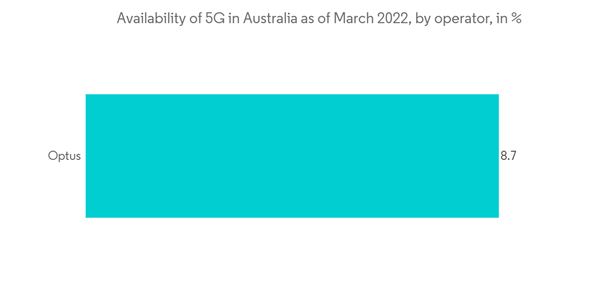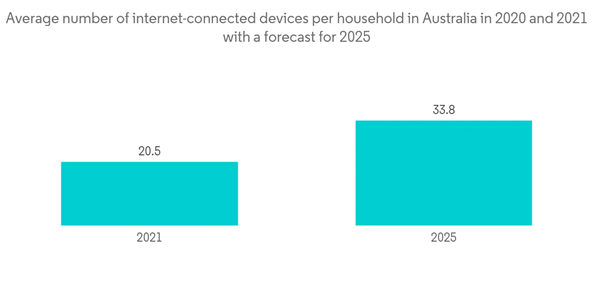The Australian retail market's top three mobile service companies are Telstra, Optus, and TPG. These three mobile service provider companies run significant, vertically integrated telecommunications operations and provide a variety of retail goods for various mobile services.
Key Highlights
- Australian telecom companies are maximizing the advantages of a cloud transformation with cloud services like analytics, machine learning, and artificial intelligence (AI) to become data-driven organizations. According to Deloitte estimates, 38% of organizations in Australia are making significant investments in AI. With the widespread use of the cloud in 2020, telecom organizations across the country are benefiting from more control over their data.
- Australian telecom businesses may set the bar high for utilizing the intelligent edge's potential. Australia is among the first nations to implement 5G, and it has a thriving market for technology and system integration providers. The fusion of these technologies may be tested by Australian businesses to further their digital transformation efforts to a greater degree.
- With three active networks, Australia is leading in the deployment of 5G. Australia's mobile network operators (MNOs) had around 4,000 operational 5G base stations installed by the end of 2021, and more were added in 2022. The industry is conducting 5G technology trials with assistance from the Australian government's 5G Innovation Initiative. According to statistics gathered by the GSMA Intelligence, Australia is the third in the world in terms of the number of 5G-connected devices per person.
- Even though the Australian government made clear its commitment to help MNOs install the 5G network quickly and effectively, a lot still rests on MNOs spending money on infrastructure. Even when MNOs purchase more spectrum, the network still needs extra physical infrastructure to support it to provide the coverage and use it can. The Measuring Broadband Australia initiative was extended in 2021 and now covers other market segments, namely NBN fixed. Other superfast access networks offer fixed-line and wireless services.
- As per the Department of Infrastructure, Transport, Regional Development, Communications, and the Arts, an average home will require 420 gigabytes (GB) of monthly data by 2026, which is more than four times the demand in 2016. This prediction is made in the BCAR's Demand for Fixed-Line Broadband in Australia working paper. The development of the National Broadband Network should offer enough broadband capacity for Australian homes, both now and during the decade, despite the country's rapidly increasing data consumption.
- COVID-19 put an unprecedented amount of demand pressure on Australia's communications network. Schools, homes, and many businesses switched to remote working, learning, and socializing almost overnight. All these activities need high-data video communications and web access. According to the Australian competition and consumer commission (ACCC), persistent demand for broadband services and capacity will continue to increase. Technology and communications have enabled Australians to work from home, continue their studies, and stay connected throughout the COVID-19 pandemic. Technological development chances align with the quick development of some key technologies that support Australia's digital economy. By 2022, new telecommunication market opportunities and potential for new company models will be produced by Australia's economic and technical changes.
Australia Telecom Market Trends
Australia's 5G Deployment
- Australia leads the deployment of 5G with three active networks. Australia's mobile network operators (MNOs) had around 4,000 operational 5G base stations installed by the end of 2021, and more were added in 2022. The industry is conducting 5G technology trials with assistance from the Australian government's 5G Innovation Initiative. According to information gathered by the Global System for Mobile Communications Association (GSMA) Intelligence, Australia now holds third place in the number of 5 G-connected devices per person.
- Overall, 5G is anticipated to provide significant productivity advantages. According to an economic analysis done in the abovementioned report, 5G would boost Australia's gross domestic product (GDP) by USD 67 billion from its current level by 2030. This estimate is comparable to earlier ones that discovered sizable overall advantages in important sectors like healthcare, finance, advanced manufacturing, and consumer entertainment. According to the GSMA analysis, if Australia can retain its present level of leadership in the adoption rate of 5G devices (compared with the current anticipated trajectory), the increase will be worth USD 27 billion by 2030 (in 2022 dollars).
- Industry-specific 5G use cases, such as greenhouse automation in agriculture, remote stock monitoring in manufacturing, data analytics for patient outcomes in healthcare, and traffic monitoring for smart cities, are of particular interest to corporate executives. This is notably different from earlier generations of mobile technology when uses such as mobile networking, data, apps, etc., were more broadly applicable to the economy. Organizations in professional services and information, media, and telecommunications have the greatest degrees of industry readiness for 5G, based on developing a single index on 5G readiness informed by various factors.
- According to an ACCC report, with more than 3,800 active 5G sites countrywide, MNOs continued to quickly roll out their 5G consumer access networks over 2020-21. Consumers may expect higher internet speeds from 5G networks, enabling applications that need ultra-low latency and widespread connection. Faster download speeds for customers using 5G-enabled devices are the main effect of 5G networks on retail services.
- As per the ACCC study, the networks are generating revenue from access to 5G availability in significantly different methods. For instance, Telstra limits access to its 5G access network to consumers who sign up for post-paid service contracts that cost at least USD 65 per month or pre-paid plans that need at least USD 60 in recharges. Contrarily, all of Optus' post-paid plans, which start at USD 45 per month or more, come with access to 5G. Similarly, Vodafone, TPG's 5G network connectivity, is available on all its post-paid plans starting at USD 40 per month. Vodafone provides 5G connection on its pre-paid slate.
IoT in Australia’s Telecom Market
- The maturation of the person-to-person (P2P) telecoms sector compelled the telecommunication service providers in Australia to seek new sources of revenue to expand. Given that there are many more machines than humans worldwide, the concept of Machine to Machine (M2M) communication services is quite appealing. This goal can be realized with IoT, which will also lead to an increase in connection quantities. This enormous growth possibility in Australia's telecom sector has created a huge buzz in the IoT business.
- Australia's telecommunications and media landscape is changing tremendously due to emerging technology and changing consumer preferences. The Internet of Things (IoT) has been a significant force of change in the past ten years, revolutionizing corporate structures and consumer experiences. IoT refers to numerous wireless and wired linkages of personal, consumer, and industrial devices, enabling diverse applications without being restricted to technological platforms, industries, products, or devices. IoT device data may bring fresh perspectives, especially when paired with powerful analytical tools.
- IoT is a developing income stream in the telecoms industry. As per a study by IoT business news in 2021, Telstra's IoT revenue increased by just 4.9%. This shows a little improvement over the growth in 2020 (4.7%). Both numbers are unexpected, given that the number of IoT connections increased by more than 20% both years.
- Australia is deploying a number of IoT technologies. NB-IoT is a widely utilized IoT technology. Fixed environment communications are a good fit for NB-IoT and voice transmissions cannot be sent through it. In Australia, NB-IoT networks were set up by Telstra, TPG Telecom Limited (formerly Vodafone Hutchison Australia (VHA)), and Optus. According to VHA, its NB-IoT footprint offers applications like elderly care management and smart building services, supporting 89% of the Australian population.
- As per a study by Techwire Asia, the Telstra Control Centre powered by Cisco is the result of a partnership between Telstra and Cisco to give enterprises sophisticated connection management for IoT services. Telstra offers more visibility and flexibility to manage their businesses better and transform IoT data into useful decision-making tools for thousands of customers, including Australia's major financial institutions, retailers, and the government. Telstra uses Cisco's IoT Control Center SaaS solution. Through their IoT devices, Australian businesses can benefit from 5G with greater business outcomes. Integration across sectors will be crucial to ensure 5G and IoT can give the greatest outcomes with more use cases.
Australia Telecom Industry Overview
The Australian telecom market is highly fragmented in nature. Some major players in the market include Telstra Corporation Limited, TPG Telecom Limited, Singtel Optus Pty Limited, Hutchison Telecommunications (Australia) Limited, and Macquarie Telecom Group Limited. The market also hosts other Internet service providers (ISPs), MVNOs, and fixed-line service providers. Some Australian telecommunication companies are very competitive internationally and hold strong ground in the global telecom space.- In May 2022, TPG Telecom announced launching fast broadband services. TPG Telecom is the first significant telecom in Australia to use G.Fast technology, enabling its fiber-to-the-building (FTTB) network to offer extremely fast download rates of up to one gigabit per second (1,000 Mbps).
- In September 2022, Aussie Broadband introduced a partner program aimed at resellers to increase its nationwide presence aimed at resellers. The initiative is anticipated to provide Aussie Broadband with broader market reach through partners selling branded services, providing channel players with "increased benefits."
Additional Benefits:
- The market estimate (ME) sheet in Excel format
- 3 months of analyst support
This product will be delivered within 2 business days.
Table of Contents
Companies Mentioned (Partial List)
A selection of companies mentioned in this report includes, but is not limited to:
- Telstra Corporation Limited
- TPG Telecom Limited
- Singtel Optus Pty Limited
- Hutchison Telecommunications (Australia) Limited
- Macquarie Telecom Group Limited
- Spark New Zealand Limited
- Aussie Broadband
- Next Telecom
- Super loop Limited
- Chorus Limited
- Huawei Australia










